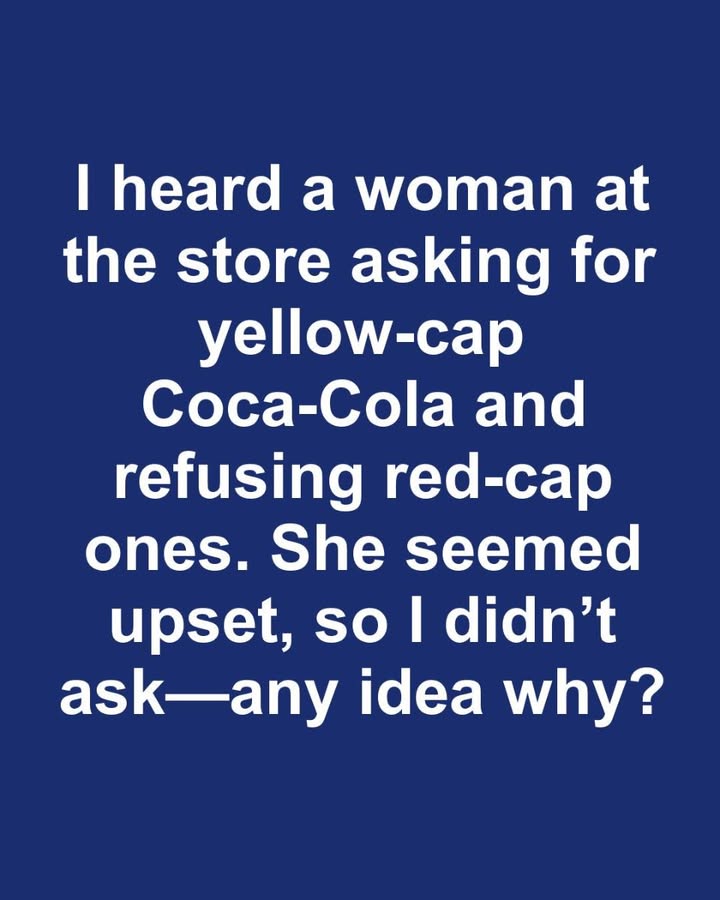While shopping at my local grocery store, I recently overheard a woman urgently requesting Coca-Cola with a yellow cap and firmly rejecting the red-cap version. Her insistence and intensity immediately caught my attention, and though I was curious, I refrained from asking her directly what made the yellow-cap bottle so important.

This brief yet intriguing encounter left me puzzled and eager to understand the reason behind such a strong preference for a seemingly small detail. As someone who has always thought of Coca-Cola as a universally consistent product, I had never noticed that the color of the bottle cap could hold any real significance. But as I began digging into the matter, I quickly learned that Coca-Cola does, in fact, use different cap colors for very specific reasons. These color distinctions often indicate a variation in ingredients, formulations, or even packaging related to cultural or religious practices.
Most of us are familiar with the classic red cap on Coca-Cola bottles, which has become iconic and globally recognizable. However, that yellow cap turns out to represent something much more than just a branding decision—it reflects a special version of the soda designed to meet the dietary restrictions of a specific religious observance. During Passover, observant Jews avoid leavened foods and grains like corn, which includes ingredients derived from corn such as high fructose corn syrup. Since standard Coca-Cola is sweetened with high fructose corn syrup in the U.S., it’s not considered kosher for Passover. To accommodate Jewish consumers who adhere to these religious dietary laws, Coca-Cola produces a limited-time version of the soda sweetened with cane sugar instead of corn syrup. This special version is marked with a yellow cap to make it easily identifiable during the Passover season. For some consumers, the yellow cap is a matter of religious compliance, but for others, it’s simply a matter of taste.
There are plenty of people who believe that Coca-Cola made with cane sugar tastes better, cleaner, or more like the original formula from decades ago. This preference has led some individuals—whether or not they are Jewish—to specifically seek out the yellow-cap version when it’s available, even stocking up on it due to its seasonal rarity. Others may view cane sugar as a more natural alternative to high fructose corn syrup, which has been the subject of health concerns in recent years. Although both sweeteners provide similar calorie content, cane sugar is often perceived as the healthier or more traditional option, influencing some health-conscious consumers to prefer the yellow-cap bottle. Coca-Cola is known for adjusting its formula to cater to local markets and consumer preferences around the world.
In countries like Mexico, for example, Coca-Cola has long been made with cane sugar, and many Americans go out of their way to find “Mexican Coke” because of its nostalgic taste. The existence of yellow-cap Coca-Cola in the U.S. represents another example of how the brand accommodates cultural, religious, and even regional differences. From a marketing perspective, the yellow cap also introduces a sense of exclusivity and scarcity. Since it’s only available for a limited time each year, consumers who prefer it often treat it like a collector’s item or specialty product. This limited-time availability creates urgency, prompting fans to purchase it in bulk or seek it out at specialty retailers. The design of the packaging—particularly the cap—plays a larger role in product identification and branding than many of us realize. Whether it’s because of religious adherence, nostalgic attachment, perceived health benefits, or a simple flavor preference, the yellow-cap Coca-Cola has gained a devoted following. The woman I encountered in the grocery store may have had any one of these reasons for insisting on that specific version, and now I understand that her preference was not random at all. Instead, it reflects a fascinating intersection of culture, faith, tradition, and personal taste. Something as simple as a cap color turns out to be a meaningful indicator that shapes the choices people make, reminding us that even in everyday products, there are layers of significance waiting to be discovered.





